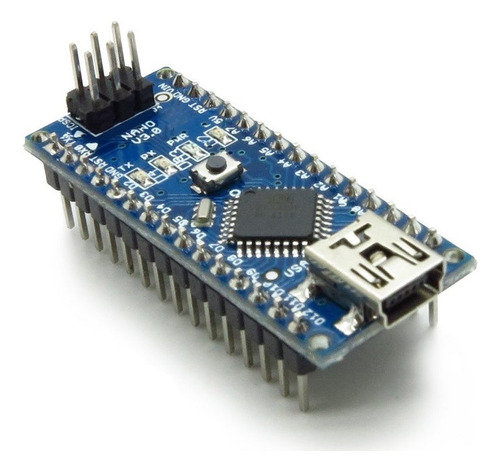Arduino Nano V3 Atmega328 - Generico + Cable Usb
en 6 meses sin intereses de
Stock disponible
+25 ventas
- Tienes 30 días desde que lo recibes.
Compra ProtegidaSe abrirá en una nueva ventana, recibe el producto que esperabas o te devolvemos tu dinero.
+25
Ventas concretadas
Brinda buena atención
Entrega sus productos a tiempo
Medios de pago
Hasta 12 meses sin tarjeta
Tarjetas de crédito
Tarjetas de débito
Efectivo





Características del producto
Características principales
Marca | OEM |
|---|---|
Modelo | Nano 3.0 |
Otras características
Microcontrolador | ATmega328 |
|---|---|
Voltaje de funcionamiento | 5 |
Voltaje de entrada recomendado | 7-12V |
Voltaje de entrada límite | 7-12V |
Frecuencia del reloj | 16 MHz |
Capacidad SRAM | 2 KB |
Capacidad de EEPROM | 1 KB |
Cantidad de entradas análogas | 8 |
Incluye cable USB | Sí |
Descripción
****************** COLDFIRE ELECTRONICA *******************
---->> PRODUCTO COMPLETAMENTE NUEVO, SELLADO EN SU EMPAQUE.
Si tu proyecto requiere de algo muy compacto y ligero, el Arduino Nano es la solucion !
The arduino Nano is a small, complete, and breadboard-friendly board based on the ATmega328 (arduino Nano 3.0) . It has more or less the same functionality of the Arduino UNO, but in a different package. It lacks only a DC power jack, and works with a Mini-B USB cable instead of a standard one.
The Arduino Nano can be powered via the Mini-B USB connection, 6-20V unregulated external power supply (pin 30), or 5V regulated external power supply (pin 27). The power source is automatically selected to the highest voltage source.
The FTDI FT232RL chip on the Nano is only powered if the board is being powered over USB. As a result, when running on external (non-USB) power, the 3.3V output (which is supplied by the FTDI chip) is not available and the RX and TX LEDs will flicker if digital pins 0 or 1 are high.
Each of the 14 digital pins on the Nano can be used as an input or output, using pinMode(), digitalWrite(), and digitalRead() functions. They operate at 5 volts. Each pin can provide or receive a maximum of 40 mA and has an internal pull-up resistor (disconnected by default) of 20-50 kOhms.
In addition, some pins have specialized functions:
* Serial: 0 (RX) and 1 (TX). Used to receive (RX) and transmit (TX) TTL serial data. These pins are connected to the corresponding pins of the FTDI USB-to-TTL Serial chip.
* External Interrupts: 2 and 3. These pins can be configured to trigger an interrupt on a low value, a rising or falling edge, or a change in value. See the attachInterrupt() function for details.
* PWM: 3, 5, 6, 9, 10, and 11. Provide 8-bit PWM output with the analogWrite() function.
* SPI: 10 (SS), 11 (MOSI), 12 (MISO), 13 (SCK). These pins support SPI communication, which, although provided by the underlying hardware, is not currently included in the arduino language.
* LED: 13. There is a built-in LED connected to digital pin 13. When the pin is HIGH value, the LED is on, when the pin is LOW, it's off.
The Nano has 8 analog inputs, each of which provide 10 bits of resolution (i.e. 1024 different values). By default they measure from ground to 5 volts, though is it possible to change the upper end of their range using the analogReference() function.
Additionally, some pins have specialized functionality:
* I2C: 4 (SDA) and 5 (SCL). Support I2C (TWI) communication using the Wire library (documentation on the Wiring website).
* AREF. Reference voltage for the analog inputs. Used with analogReference().
* Reset. Bring this line LOW to reset the microcontroller. Typically used to add a reset button to shields which block the one on the board.
CARACTERISTICAS TECNICAS:
* Microcontroller: Atmel ATmega328.
* Operating Voltage (logic level): 5 V.
* Input Voltage (recommended): 7-12 V.
* Input Voltage (limits): 6-20 V.
* Digital I/O Pins: 14 (of which 6 provide PWM output).
* Analog Input Pins: 8.
* DC Current per I/O Pin: 40 mA.
* Flash Memory: 32 KB (ATmega328) of which 2 KB used by bootloader.
* SRAM: 2 KB (ATmega328).
* EEPROM: 1 KB (ATmega328).
* Clock Speed: 16 MHz.
* Dimensions: 39 x 13 x 12 mm.
*** INCLUYE CABLE USB ***
Garantía del vendedor: 30 días
Preguntas y respuestas
Pregúntale al vendedor
Nadie ha hecho preguntas todavía.
¡Haz la primera!
